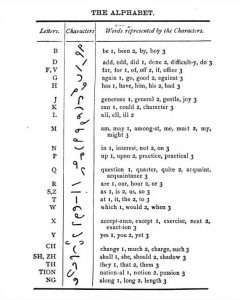[Editor's note: This blog post originally appeared in Vita Brevis on 3 October 2016.]
One day, when searching through the town records of New Haven, Connecticut, I was struck by one of the entries. The writing appeared like nothing I had ever seen before. After asking others for their thoughts, we found that none of us had ever seen this form of writing before. After some research, I discovered that what I had found was notation written in Taylor Shorthand, a system of writing developed by Samuel Taylor in 1786, the first system of shorthand writing to be widely used across the English-speaking world.[1]
Shorthand has long been used as a method of notation, often when time or efficiency is imperative, and as a result, it often appears in court documents and meeting minutes. The first known shorthand system was developed by Roman Marcus Tillius Tiro c. 60 B.C. Tiro’s shorthand employed abbreviations which are still in use today including ‘et’ for the word and as well as ‘viz,’ meaning namely.[2]
Other systems of shorthand gained popularity starting in the eighteenth century. One such system was Universal English Shorthand, developed by John Byrom.[3] The purpose of shorthand systems was made clear in the preface to The Universal English Shorthand (published in 1767), presenting Byrom’s system. This work stated that “Mr. Byrom’s method of short-hand may be termed, the art of expressing all the words and phrases of the English tongue by a character, which is perfectly regular and beautiful, and, as we conceive, the shortest possible.”[4]
In Taylor Shorthand, vowels are omitted from words except when they begin or end a word, in which case they are represented by a single dot.
The system developed by Samuel Taylor utilizes characters as shortened forms of letters and words, and was applied in the recording of many records and court documents upon its development in the late eighteenth century. In Taylor Shorthand, vowels are omitted from words except when they begin or end a word, in which case they are represented by a single dot.[5] In many cases, symbols which represent a single letter are also used as an abbreviation for common words in stenography (see table above).[6] The style of writing also contains other unique methods which were generally used to save time. For example, when two consonants come together with the removal of a vowel, the symbol for that consonant is written once in a larger size.[7]
Since the publication of Taylor’s shorthand method in 1786, other forms of shorthand have also come into popular usage, including Pitman’s Shorthand, which was developed and published by Sir Isaac Pitman in 1837. Pitman’s Shorthand was unique in that silent and voiced sounds were represented by lines differing in thickness, requiring the writer to use a proper writing implement to successfully convey the correct sounds or syllables.[8]
The rise of typewriters, and more recently, personal computers, has led to a significant drop in the importance of shorthand notation. Despite this, a knowledge of these writing systems and their application in the transcription of records in past centuries remains important to genealogists.
Notes
[1] Sir Isaac Pitman, A History of Shorthand (1891), 48–55.
[2] David A. King, The Ciphers of the Monks: A Forgotten Number-Notation of the Middle Ages (2001), 61–63.
[3] John Byrom, The Universal English Short-Hand (1767).
[4] Ibid., i.
[5] Alfred Janes, Standard Stenography: Being Taylor's Shorthand (1882), 18.
[6] Ibid., 6.
[7] Ibid., 10.
[8] Sir Isaac Pitman, Brief Course in Isaac Pitman Shorthand: An Exposition of the Author's System of Phonography, Arranged in Twenty-seven Lessons (1914), 3.
Share this:
About Zachary Garceau
Zachary J. Garceau is a former researcher at the New England Historic Genealogical Society. He joined the research staff after receiving a Master's degree in Historical Studies with a concentration in Public History from the University of Maryland-Baltimore County and a B.A. in history from the University of Rhode Island. He was a member of the Research Services team from 2014 to 2018, and now works as a technical writer. Zachary also works as a freelance writer, specializing in Rhode Island history, sports history, and French Canadian genealogy.View all posts by Zachary Garceau →
